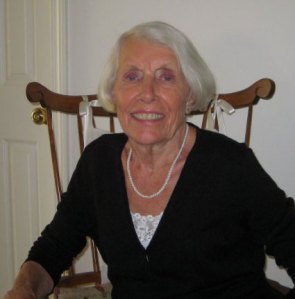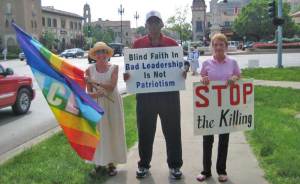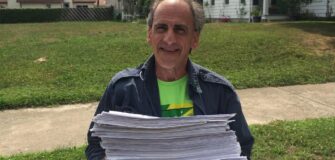Looking at the Party from the beginning
Share
Spotlight on founder Dee Berry
 Dee Berry is a founder and still-active member of the Green Party in the United States. She took some time to answer questions for Green Pages on how the Green Party evolved in this country and where she thinks it should go in the future.
Dee Berry is a founder and still-active member of the Green Party in the United States. She took some time to answer questions for Green Pages on how the Green Party evolved in this country and where she thinks it should go in the future.
Why have you joined the Green Party?
I was attracted to the Greens, like so many others, by its ecological, holistic view of the world and its ten key values. During the 60ís and 70ís, I had participated in the various movements that were springing up across the country and the planet in that exciting and pregnant timeóthe civil rights movement, the feminist movement, the environmental movement and the anti-war movement.
1972, I was very active in the McGovern campaign, organizing the 10th ward in Kansas City.†It was during that campaign I witnessed first hand how corrupt and unredeemable the Democratic Party really was. Soon after McGovernís devastating defeat, I left the Democratic Party for good.†I realized then how desperately our country needs a new third party. So I was very excited when I found the Greens and I threw my heart and soul into organizing a Green presence in this country.

I saw the Greens as a place where all of my interestsópeace, feminism, the environment, and civil rights came together.†By working in the Greens I could be involved in all of them.†But even more important, I believed that our society was in a deep crisis.†The modern, industrial society has reached its limits to growth and is breaking down.†All of the immense, seemingly unsolvable, worldwide problems are related and are symptoms of this dying order. Our very survival depends on our ability to transform the way we see the world and the way we live and play together, and of course, our politics.†For me, the Greens are the ones who truly understand this and are inventing the blue print for a new compassionate, connected, sustainable society.
I joined the Greens in 1984 long before it was a Green Party.†In August of í84, Charlene Spretnak and David Hanke invited people from across our country to come to St. Paul, Minnesota to organize a Green presence in the U.S.†Green parties were emerging in many countries in Europe, especially Germany and Sweden, and green ideas were capturing the imagination of people across the planet, people who realized there was a crisis of modernity and were looking for a new way.†Charlene had just published her book Green Politics: The Global Promise, and found there was a great deal of interest in Green ideas in the U.S. as well. From that first meeting came the name, the Committees of Correspondence (CoC), the ten key values, and the organizational structure.
The U.S. Greens would be organized into bioregional entities that would send delegates to an Interregional Committee (the IC)óand a clearinghouse was established in Minneapolis. The first IC meeting was held in the home of Fritjof Capra and the second was held in Boston, MA. At the third meeting held in Kansas City, it was decided to move the Clearinghouse there and I was named the coordinator, a position I held for over three years. Dur ing that time the Greens grew from a smattering of locals, no one really knew how many, to over 350.
Some were organized into well functioning regions such as California, New England, and the Prairie; while others were loosely organized into bioregions.†This organizational structure lasted for five years and was restructured in 1990.
What do you think are the pressing issues of the country?
I believe our country is on the verge of a collapse beyond anything we have seen before. The pressing issues are all interrelated and the result of the breakdown of industrial society.†Our best hope is that this crisis will awaken the American people to the need for fundamental change including a political realignment. Since both the Republicans and the Democrats are mired in the modern corporate culture, which is at the root of the crisis, they are unable to see beyond the tired solutions already proven to be inadequate. Greens have been talking about peak oil, alternative energy, food circles, single-payer health care, simple living, and community building for almost twenty years.†A desperate citizenry just might begin to listen and take the Greens seriously.†The Greens must be ready for the challenge.
What do you think the Green Party should focus on?
I believe Greens should focus on the grassroots, community level. This is where most of the workable, practical solutions that we have been proposing for years can be more easily put into effect.†Also, I doubt many of the huge institutions of centralized power will come through the crisis unscathed, be they† governmental, profit, or even not-for-profit. There will be a devolution of this concentrated power, not only because it is not working, but also because centralizing power and people is becoming prohibitively expensive with the end of the fossil fuel age.
How has the Green Party changed over time?
The Greens, in the larger sense, have changed a great deal over time. We started out in 1984 as a bio-regionally organized movement, called the Committees of Correspondence (CoC) and later changed our name to Green Committees of Correspondence (GCoC). In West Virginia in 1990 the GCoC was restructured into what was called the Green Party/Green Party USA. However, this was the result of a very contentious, heavy-handed process and many activists simply voted with their feet and walked away, I being one of them.†The GP/GPUSA continued, but lost much of the energy and exciting promise of the original CoC and slowly lost members.
Some of us who left did not want to lose contact with the many good Green friends we had enjoyed over the years so we organized the Green Politics Network.†This organization has been much maligned and little understood. But we never pretended to be more than what we said we were: a safe home where we could enjoy each other, meet together and discuss Green issues and ways to grow into a vibrant political party without being personally attacked.
Most of all we wanted to be the catalyst for a Green Party in the U.S. We succeeded in doing that. Through the work of our members with the Third Force Conferences, the Nader run for President in 1996, and the organizing meeting of the Association of State Green Parties in December of ë96, a new Green Party in the country was launched.
With the birth of the Green Party, the Green Networkís mission was accomplished and we disbanded. But there was another legacy of the Green Network, this was our organizing idea of connected, separate but autonomous working groups. At present there are many exciting and autonomous Green organizations doing fantastic work like the Green Horizon, Liberty Tree, Democracy Unlimited of Humboldt County, the Green Institute, and Mike Feinsteinís archival project.
These groups are composed of strong leaders in the Green Party,†but with the Green principle of turning over leadership, they have gone to other organizations. As a result, there are a plethora of organizations doing their bit to Green our planet.†I would like to see a way for these organizations to be more connected to the Green party while still remaining separate and autonomous. I think they could be a real asset to the party and could help other Green leaders find leadership roles in the larger Green movement. †As I see the evolution of the Greens in the U.S., they began as a movement, re formed almost exclusively into a party, and now I would like to see an integration of the two.
Could you please give a brief biography?
I am a wife of 58 years, mother of five, and grandmother of eight.†Finding a balance between my commitment to my family and my equally strong desire to be involved in my larger familyóthe earth community, has always been a challenge for me. I am a graduate of the University of Iowa and received an MBA from the University of Missouri. I taught at various area colleges and liked exploring green ideas in my classes long before there was a green movement.
My Green work includes: serving three and a half years as the coordinator of the national clearinghouse of the CoC, organizing along with Ben Kjelshus, the Kansas City Greens, which has been active for almost twenty-five years, helping to organize and coordinate the Prairie Region, participating in forming the Green Politics Network and editing its interactive newsletter ìThe Song of The Frog,î co-organizing the Missouri Green Party and later the Progressive Party of Mis souri. I just stepped down as co-chair of that party and as its delegate to the National Com mittee of the Green Party of the United States. I am presently secretary of the PPMo, alternate delegate to the National Committee and membership chair of the Kansas City Greens.†I serve on the Platform Com mittee and the Committee on Bylaws, Rules, Policies and Procedures of the US/GP.
One of my main concerns in the Greens has always been to make sure that womenís voices are heard. While I enjoy many things like sewing, reading, playing bridge, cooking for and entertaining my family and friends, my passion is the Green Party/Movement, which I fervently believe, is our best, if not only, hope for the future.





